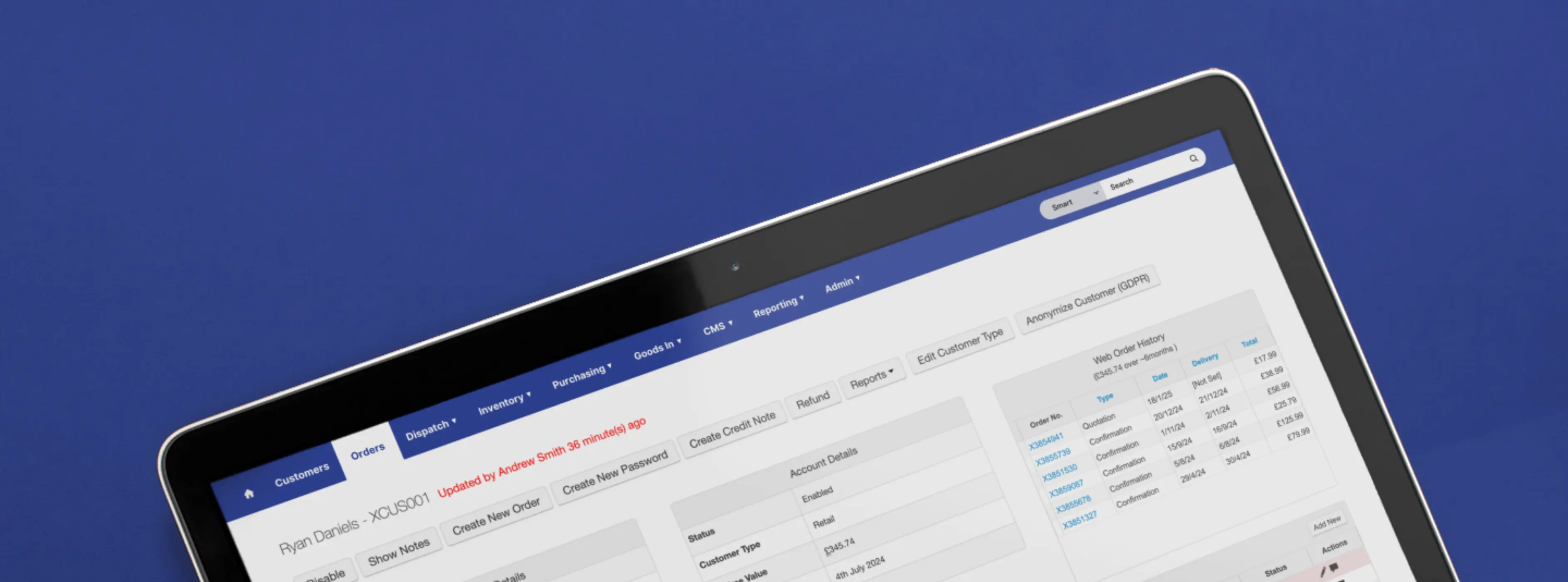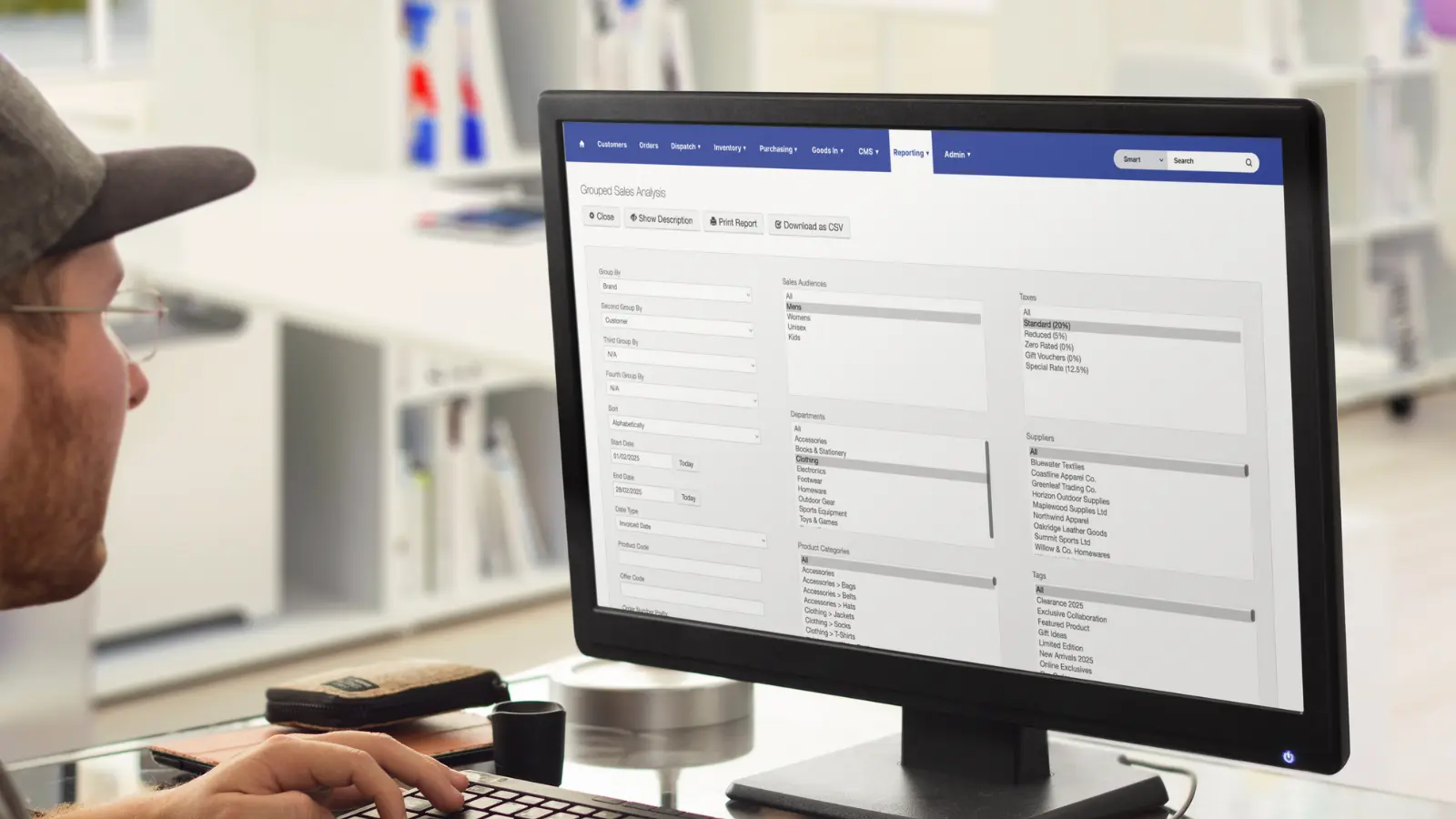Product data isn’t just about listing titles, prices, and images—under the hood, there’s a structured framework that organises everything you upload into neat, tidy tiers.
We call this a product data model. It keeps every data point, from colour variations to stock levels, organised and accessible.
At the core of Venditan Commerce lies a flexible structure that allows us to shape, manage, and present your product data exactly how you need to.
Whether it’s adapting to complex product hierarchies, supporting a wide range of product variations, or simplifying your marketplace integrations, our data model is built to handle it all.
In this article, I’ll explain our product data model in more detail and break down the key advantages it provides for our clients.
Our product data model: Master, Member, Stock
If you’ve ever browsed an eCommerce store and filtered products by size, colour, or other options (it’s 2024, of course, you have!), you’ve interacted with a product data model—whether you knew it or not.
Our platform uses a tiered model of Master, Member and Stock, which organises product data into three levels.
- Master (Top Hierarchy): At the top of the hierarchy is the Master level.
If you’re selling a particular pair of trainers, the Master product is the overall entry for that trainer style. It serves as the top of the hierarchy, organising and grouping different variations beneath it.
While the Master level can include basic information like product names and descriptions that filter downward to its Members, its primary role is to act as the holding point for all related variations. - Member (Product Variations): Beneath the Master level is the Member level, where the specific variations of the Master product are detailed.
Continuing with the trainer example, Members would represent different colours or designs.
Members inherit essential details from the Master by default, but can also have unique attributes, such as specific images, additional descriptions and even different prices–more on this later.
- Stock (Inventory Tracking): At the base of the hierarchy is the Stock level, which deals with individual inventory items.
This level is crucial for managing real-time inventory, including details like sizes, materials, or other attributes that affect stock.
Each Stock item has a quantity and availability, ensuring accurate tracking and order fulfilment.
It’s all about efficiently managing complexity and unlocking the full potential of your product catalogue.
As your business grows and your product offerings diversify, the ability to handle various product types and configurations becomes crucial.
Let’s delve a little deeper into the advantages of the model.
Simplify your product information management at scale
Managing a large product catalogue can become overwhelming, but grouping product variations under single Master sets helps keep your data clean and manageable.
The strength of this model lies in its scalability. As your business grows, new variants can be easily added at the Member or Stock levels without disrupting your existing product setup.
Whether you're introducing a new colour to an existing product line or expanding to different sizes, you can add it to the structure without having to start from scratch.
Beyond just organising products, this model ensures that your product data is efficiently managed.
The hierarchical structure keeps everything logically arranged when updating key details like Product Descriptions, Prices, or Stock Levels, making it much easier to maintain and update over time.
Flexibility is another key advantage. You have full control over how and where product data is held.
For example, you can store overarching information such as Product Descriptions and base Pricing at the Master level, allowing it to filter down to all variations. Alternatively, you can set different prices for each Member or Stock item of the same product.
Create advanced product types
One of the standout features of our platform’s data model is its ability to support advanced product configurations right out of the box.
This flexibility allows you to create a diverse range of product types that cater to your specific business needs without requiring additional plugins or development time.
- Product Sets: At its core, the data model enables variable products with different options and variations. Whether you’re selling clothing with various sizes and colours or electronic gadgets with different specifications, Product Sets make it easy to manage all variations under a single product listing.
- Bundles: Our platform lets you create product bundles by combining groups of products (e.g., T-shirt, shorts, and socks) into a single bundle. Customers can choose from eligible Stock items for each product and check out as one product in one transaction. Stock is automatically deducted from the individual Stock items in the bundle.
- Bills of Materials (BOMs): You can also configure combinations of different Stock items into pre-set bundles you control. Take, for instance, an arts and crafts set that includes a variety of supplies such as paints, brushes, and canvases. This setup allows you to offer curated product experiences that make it easier for customers to find what they need in one convenient package.
- Standalone Items: Of course, you can also manage individual products without variations, making it easy to list items that don’t require further configuration.
- Service Items: Standalone Items with no stock levels, e.g. In-store services like consultations and gift wrapping.
This range of advanced product configurations isn’t commonly available on other platforms without additional plugins and associated costs.
These configurations also help digitise sales workflows that previously required offline execution, streamlining your operations and enhancing overall efficiency.
Optimise your stock tracking
By attributing stock levels to the Stock tier of the data model, we can deliver precise tracking of individual items throughout your operations.
But what if you hold these items across various locations, such as multiple warehouses or physical stores? That's where Locations, Stores, and Bins come into play.
The Stock held against an item can be split across different Locations, meaning each SKU will have a stock level specific to each Location you operate. This flexibility allows you to manage your inventory effectively, regardless of the size or complexity of your operations.
Within those Locations, you can implement Bins, which provide granular stock storage tracking. This means that not only can you see the total stock level of an item across all your Locations, but you can also specify exactly where each item is stored down to the Bin level.
This opens up 100% visibility in tracking every item in your inventory.
Additionally, having stock level items means no ring-fencing when offering bundles or BOMs. When these products sell, they simply pull from their component stock records.
Control your marketplace strategy
One of the standout advantages of our product data model is its ability to simplify cross-platform and multi-channel selling.
Because the information is grouped and structured logically, distributing it across various channels becomes a seamless process.
When selling across multiple marketplaces, you no longer have to send the entirety of your product set to each platform.
Instead, you can easily toggle on or off Sales Channel distribution for specific member or stock variations. This level of control means you can tailor your offerings to fit each marketplace's unique requirements.
Moreover, the platform allows you to set unique product information for each marketplace. This includes adapting descriptions, titles, images, and even prices depending on where the product is sold.
Access better reporting and insight
When generating certain reports, you can group products by Master level, giving you a high-level overview of your entire product catalogue.
This is useful for assessing overall sales performance across different product categories over a specified date range.
Alternatively, you can expand your reports to include Member and Stock levels.
This capability allows you to gain detailed insights into specific product variations, helping you determine which colours, sizes, or configurations are performing best.
Final thoughts
Venditan Commerce’s product data model provides a robust framework that simplifies product information management, supports advanced configurations, optimises stock tracking and facilitates seamless multi-channel selling.
These advantages enable you to manage your product catalogue efficiently regardless of volume and complexity.
Ready to see how our platform can transform your eCommerce operations?
Contact us today to discuss your requirements, and we can demo our platform. Let’s unlock the full potential of your product data together.
Our recent posts
Keep up to date with the latest news and insight from the team at Venditan





.webp)




